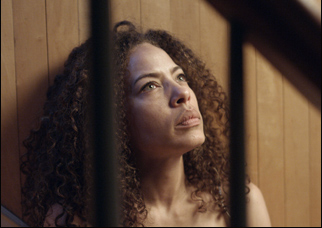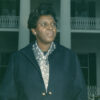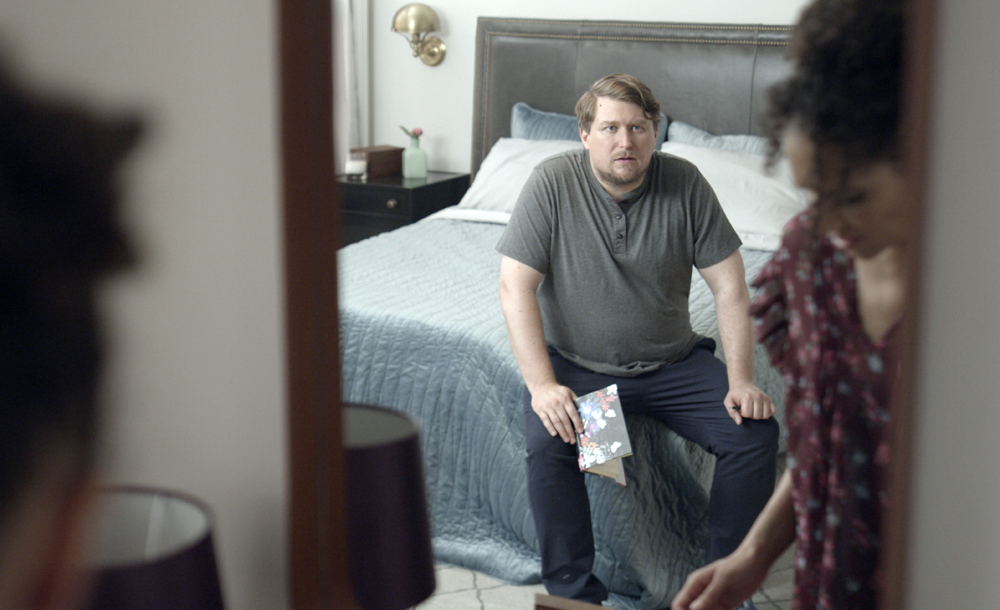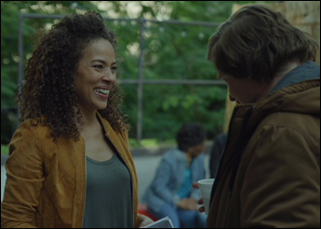“When will this business be finished?” Kira (Talia Thiesfield) asks her husband Doug (Michael Chernus) innocently enough in “Inez & Doug & Kira,” going through her sister Inez’s (Tawny Cypress) apartment in the wake of her suicide. “I can’t tell if this is normal grief or something else.”
It’s something else, although writer/director Julia Kots finds a fascinating angle into showing how there’s not such thing as “normal grief” in her feature directorial debut when looking at the way Kira and Doug are able to process Inez’s death in different ways, with both having a deeply personal connection to her. While Kira shared a womb with her twin, Doug got to see a side of her sister that she didn’t as her Alcoholics Anonymous sponsor and after introducing the two to find love on their own, Inez is recalled in memories as having to grapple with issues of bipolar disorder and alcoholism, as well as the stress of putting on a brave face to continue a successful legal career, that only revealed themselves in parts to those closest to her, leaving them to piece together what they knew only after it was too late.
The subject matter may be grim, but it’s genuinely rejuvenating to see how Kots captures so completely a portrait of a woman who was never allowed to present herself fully, chronicling how Inez feels she’s at the mercy of her medications and showing how drugs can be isolating in defining someone even when it doesn’t have biological control over them, as well as creating a unique dynamic between the trio that uncovers different forms of intimacy as Kira’s understanding of Inez largely comes the childhood spent they spent together while Doug knew Inez only as an adult. Such an intricately told tale likely couldn’t have been even conceived, let alone pulled off by anyone without the experience Kots has as an editor, and she proves to have a light touch working with a strong cast as well, with compelling performances from Chernus, Cypress and Thiesfield.
On the eve of the film’s premiere at the Woodstock Film Fest this weekend, Kots recalled a process to making her first film that was never easy, but quite rewarding, and spoke about how she managed to make such an ambitious drama on a shoestring budget.
I work full-time as a freelance editor for film and television and I’ve been trying to get a feature going for the last decade. I started out with a script of mine that was about $3 million in scope and couldn’t get that going, and then another that was about $1 million that almost came to fruition and fell apart several times, so I wrote something that was micro-budget because I was determined to make a movie, come hell or high water. What I learned from the bigger budget attempts is that there’s a million ways to say no — and I’ve heard most of them — so I wrote this very, very small film, thinking I was going to have to find this financing myself, and in some ways, it’s a departure for me because I usually do comedy, and although this has elements of dark comedy in it, it’s actually a drama, so in some ways, it’s a lot more sincere than my previous work.
It’s quite ambitious structurally since you’re essentially telling the story of this woman Inez through the parallel stories of Doug and Kira, who have very different relationships to her, as well as obviously one with each other. How did you figure out how to build this?
As the name implies, it’s the relationship between the three people that is almost the central character for me, so it’s no one person alone is the main character, but this very strange relationship dynamic between them that works. I always envisioned it in flashback, and at a certain point, I remember all the scenes on index cards spread all over my bedroom floor and rearranging them. I actually have a timeline of the actual events in chronological order and in order to keep my sanity, I actually gave [each scene] a specific day and date [even though it isn’t relevant in the film], so I have somewhere a spreadsheet where all of the scenes happen, like “January 4th, 2003.” Some of it got rearranged because if you notice the flashbacks are not chronological either way, but it’s the information that comes through the flashbacks drives the current time narrative forward. It definitely took a lot of crawling around on my floor and rearranging index cards.
What was it like once you started getting the cast involved?
They were amazing. I still can’t believe that a grown man pretended to throw up [for this film], or that this poor woman would lay in the bathtub for six hours full of fake bloody water. God bless actors. I don’t know how they do what they do, but they’re remarkable. We had very limited rehearsal and we did talk about their characters and their relationships, but they found their own way and all three of these actors really have got amazing chops and are really intelligent and sensitive people. During the reading, I also saw they were really connecting to the characters, so I didn’t prep them extensively in terms of backstory.
[And once we got to set] it was actually a very difficult shooting environment because we didn’t really have a green space. We had one room with costumes and makeup, so the [actors] would find a corner for themselves [to prepare]. A lot of them used music, just put on their headphones and in the mean time, there’d be C-stands flying an inch away from their face, but they just did what they had to do. It was difficult obviously because we were shooting in the summer. The air conditioning was a problem, so they went through a lot, but they were all just so phenomenal, and it was really an amazing experience working with them.Given that tight schedule, did your editing experience inform how you directed?
Yeah, I really enjoyed it and there was beauty in the efficiency of it because I knew everything so intimately as far as the writing, directing and editing of it. Before I shoot, I have overheads of every scene drawn to scale, so for example, I will take the floor plan [of a location] and then draw my map and fill it with actual drawings of the furniture and it’s like a dance diagram. I have where everybody moves, where the camera moves. I have the entire shotlist written out — the assistant director loved me because I’m 110% prepared when I get on set — and then we go maybe 75% goes according to plan, meaning the 25% [is where] we’re thinking the light isn’t working this way or it doesn’t feel authentic for the actors to be moving this way, so we’d rework the blocking of a scene. But 75% was shot as I drew it and having been an editor a decade prior to this, gave me intimate insight into what I wanted and how it was cut together, which was great because it freed me up to focus on performance, and additional takes would be done in order to get the performance and not get extra coverage.

The two were different. The touching of the tub was written and it was designed exactly as it was shot. The hammock scene, we play around with a bit, and I had certain angles in mind of how to shoot it, but it was a lovely day out — it wasn’t too hot, so the cinematographer and I ran around and shot flowers and bumblebees and things like that [spontaneously]. That scene was very important to me to convey the warmth of the relationship between the sisters because they’re shown in conflict throughout the entire movie and this is the first scene that was going to show their bond. The positioning of the hammock is womblike – you can imagine that’s how they were, kind of spooning each other in the womb, so [you see] the physicality of that skin to skin contact. Thankfully, the weather collaborated with us and it was just beautiful. In post-production, we punched up the saturation and made it as juicy and pleasant and beautiful and warm as we possibly could.
Was there anything that happened during shooting that was unexpected that you now really like about the film?
Some things did come out better than I envisioned them and I remember when there’s a scene of [Doug] drinking the whiskey [when he’s about to make a big decision] and when he looks at the whiskey and makes that decision, I had planned it to be by that window [of the apartment]. The way the gaffer and the cinematographer lit it, it was just so pretty and the script [actually says], “The amber color light shines through the bottle on his face” and it really worked that way. It was so beautiful that my cinematographer [Freek Zonderland] and I were jumping up and down [after the take] and Michael [Chernus, who plays Doug] looks at us and shook his head, saying, “You guys have no poker faces.” Because we would just jump up and down when something came out as good or better than we imagined it. [laughs]

What’s it like getting to the finish line with this?
[laughs] Well, it doesn’t feel real. It’s quite anticlimactic [because] there have been many finish lines. There was the finish line of locked picture, there was the finish line of when I held the DCP in my hands there’s going to be the finish line of the premiere on the 5th of October, and we don’t have distribution yet, so which one is the real finish line? It’s a process that by design doesn’t give you that feeling of crossing the finish line that one would like.“Inez, Doug and Kira” will premiere at the Woodstock Film Festival on October 5th at 12:45 pm at Upstate Films and October 6th at 2:15 pm at the Orpheum Theater in Saugerties.





